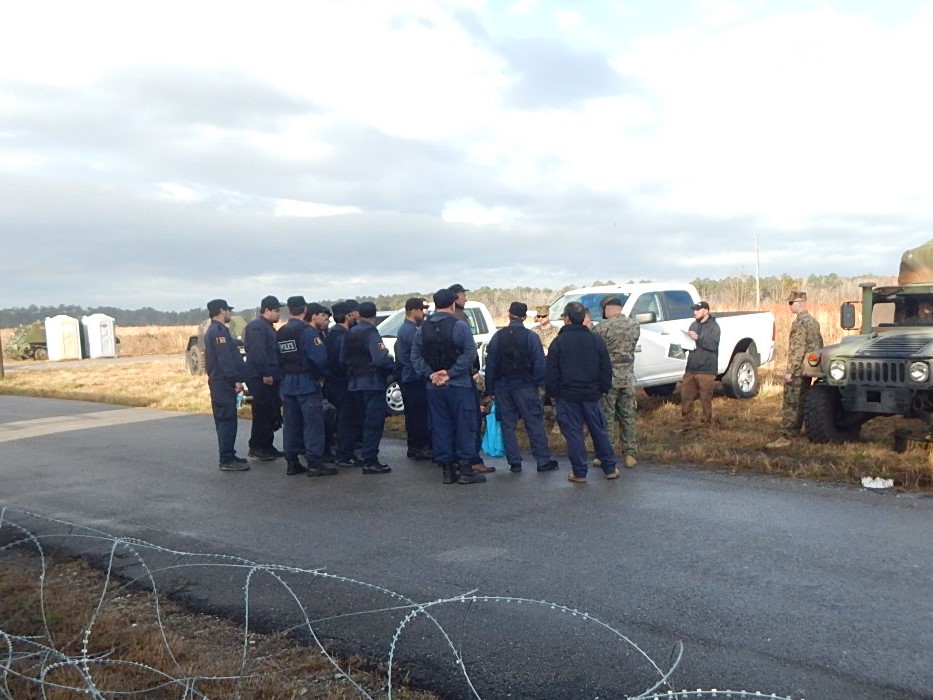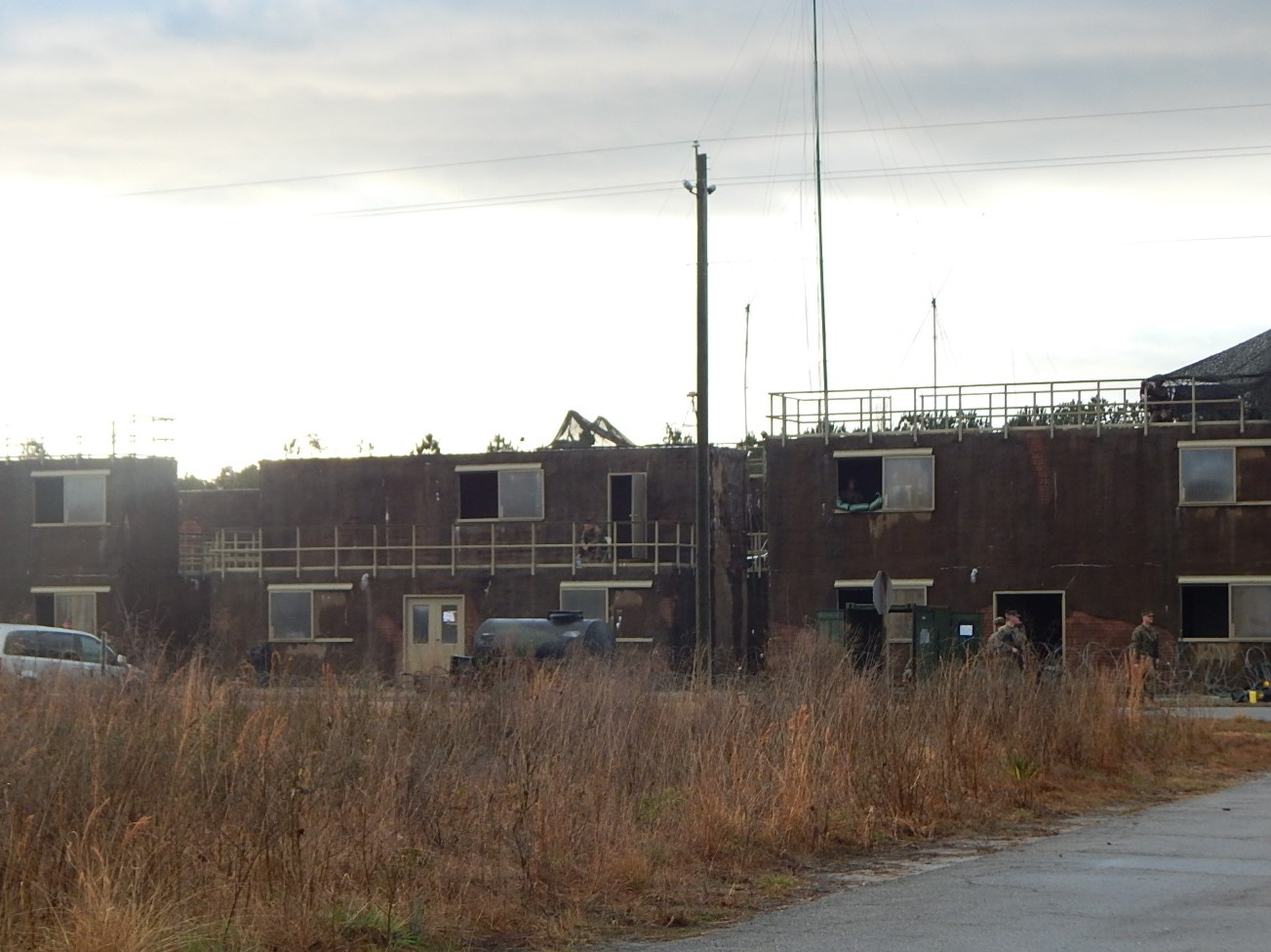Task Force Southwest (the 300-man Marine Corps unit deploying to the Helmand province this spring) had a Full Mission Rehearsal exercise at Camp Lejeune, N.C., from February 27th to March 3rd. I attended the first two days of the exercise (as an embedded reporter) with the Afghanistan National Police (ANP) training team, who will be working out of the provincial capital of Lashkar Gah. It was time well spent with a diverse crew of experienced Marines.
By diverse, I mean they are from a variety of military occupational specialties (MOSs) and they are volunteers. As mentioned in an earlier post, one of the rules for embedded journalists is not to use the name, age, and hometown of Marines in our reports. This is a force protection measure designed to prevent cyber stalking and/or cyberbullying of Marines and their families. That’s a legitimate concern these days so I won’t be focusing on individuals in this or future posts.
The ANP training team will work with the ANP 505th Zone National Police in Lashkar Gah. The ANP team is heavy on officers, most of whom are experienced captains or majors who have deployed to Afghanistan. Even the Physician Assistant attached to the team has over 12 months of experience working with Afghan Security Forces (ASF) in Tarin Kot, capital of Uruzgan province, which was a serious Indian Country.
Extensive pre-deployment exercises for Marine Corps units are designed to make the various subordinate headquarters work through their standard operating procedures (SOPs) for contingencies they anticipate encountering while deployed. They do this using the communication equipment they are deploying with and under the control of their higher headquarters (BGen Roger Turner’s command group), which will be located at Camp Shorabak (30 miles away). This exercise can be boring if the exercise control group is off its game, but that no longer seems to be a problem.

The exercise control folks are now contractors who run exercises for a living. They were excellent at keeping the problem running smoothly and inserting serious events (like a VBIED blowing up at their front gate) when least expected. Contractors are a significant improvement for designing and running exercises of this type because there is no military occupational specialty (MOS) for conducting training exercises. However, you still need experts to do it correctly.
Military theorist Carl von Clausewitz said “everything in war is simple. But the simplest thing is difficult”.
He described friction as it relates to military operations, and that was the goal of the mission rehearsal: to gum up the works with serious problems and see how the various command groups handled solving them. It’s not the most exciting evolution to watch, and it is also not that fun for the Marines working through the problems, but it’s essential to do. Operations centers need to remain calm and focused when under stress, and the only way to get them there is to stress them during their pre-mission training.

Experienced military professionals can tell how good a unit it is within minutes of watching their tactical operations control (TOC) in action. But as a member of the press I wasn’t allowed inside TOC’s so I watched the problems play out from the medical spaces. I saw what I expected to see: a group of experienced Marines working through issues in real time. Friction makes that hard to do when all the communication nets are involved (and some go down when the exercise controllers want to add stress), and I’ve seen command groups melt down with helmet fires under similar stress. The ANP training team did fine; they didn’t get too excited and never got far behind the event horizon by failing to maintain good situational awareness with their higher headquarters.
I found a corner on the second floor above medical that had not been claimed by Marines and slept there too. I knew to roll up my sleeping bag and mat and to keep my ruck packed during the day (so I didn’t stand out like a pouge), and it wasn’t long before I was making friends and chatting with the team. I liked them too – a good crew with a positive attitude and great stories from their prior deployments to Afghanistan. Plus I slept like a baby in my little corner on the second deck. I’m always awake before dawn and had a rental car staged at the airfield so I skipped out every morning for coffee and an egg sandwich. Talk about living the high life!
My best guess (and this is just a guess) is that Task Force Southwest will head into Helmand to help with the training and coordination but will remain confined to the bases from which they will be working. The 215th Corps of the Afghanistan National Army and the 205 Zone of the Afghan National Police are taking a severe beating while not getting their share of combat enablers like Tac Air (Afghans use the A-29 Super Tucano which is a good ground attack platform) which it seems are being concentrated in the east to battle an out break of The Daesh (ISIS) in Nangarhar province (where we lost another special operator last night). It appears (again to me) that the 215th Corps and 205th Zone are fighting a holding action designed to keep the Taliban focused on Helmand. At the same time, the central government in Kabul tries to consolidate its control of the strategically critical eastern provinces.
If my guess is true, then this deployment will involve a lot of risk and some potentially long-term gain, making it one of the more unique deployments in the history of the United States Marine Corps.



Glad to see you back at it again with the guys that matter out on the ground. A watchful eye on Helmand out on this end as well. Looking forward to the next report!
Thanks Pat, it’s good to be back in the game as it were